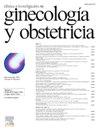Abdominal access following insufflation with Veress needle at high pressure: A security maneuver for the reduction of surgical complications during laparoscopic access
IF 0.1
Q4 OBSTETRICS & GYNECOLOGY
Clinica e Investigacion en Ginecologia y Obstetricia
Pub Date : 2025-05-09
DOI:10.1016/j.gine.2025.101051
引用次数: 0
Abstract
Introduction
Up to 50% of laparoscopic complications arise during access maneuvers to abdominal cavity. Our aim is to determine whether elevated pressures of 20–25 mmHg during these maneuvers, by increasing the distance between the abdominal wall and intracavitary organs, can help reduce the risk of entry-related complications, without an increase in anesthetic adverse effects.
Methods and materials
Prospective observational analytic multi-centered cohort study with 703 patients. The exposed-cohort consisted of patients undergoing gynecological laparoscopic surgeries in which an intra-abdominal pressure of 20–25 mmHg was used (group 20–25 mmHg) as opposed to the unexposed-cohort, in which usual < 15 mmHg pressures (group < 15 mmHg) were used. All surgeries were performed using the Veress needle as the method of insufflation.
Results
Patients in whom access was performed at pressures < 15 mmHg had a higher risk of complications than those in whom elevated pressures of 20–25 mmHg were used, which was statistically significant (OR 3.08, 95% CI95% 1.42–6.65, p = 0.004), without finding differences regarding anesthetic complications (p = 0.9).
Conclusion
The use of high intraabdominal pressure during access maneuvers serves as an effective technique for the prevention of complications, especially major complications, when compared with standard-used pressures, without increasing the incidence of anesthetic adverse effects, due to their temporary maintenance.
在高压下用Veress针注入腹部通路:在腹腔镜通路中减少手术并发症的安全操作
高达50%的腹腔镜并发症发生在进入腹腔的过程中。我们的目的是确定在这些操作中,通过增加腹壁和腔内器官之间的距离,将压力升高20-25 mmHg是否有助于减少与进入相关的并发症的风险,而不会增加麻醉剂的不良反应。方法与材料703例患者的前瞻性观察分析多中心队列研究。暴露队列由接受妇科腹腔镜手术的患者组成,其中使用20-25 mmHg的腹内压(20-25 mmHg组)与未暴露队列相反,其中通常使用<;15毫米汞柱压力(组<;15 mmHg)。所有手术均采用Veress针作为充气方法。结果在压力下进行访问的患者;15 mmHg组的并发症风险高于20-25 mmHg组,差异有统计学意义(OR 3.08, 95% CI95% 1.42-6.65, p = 0.004),麻醉并发症无差异(p = 0.9)。结论与标准压力相比,使用高腹内压可有效预防并发症,特别是主要并发症的发生,且由于其暂时性维持,不会增加麻醉不良反应的发生率。
本文章由计算机程序翻译,如有差异,请以英文原文为准。
求助全文
约1分钟内获得全文
求助全文
来源期刊

Clinica e Investigacion en Ginecologia y Obstetricia
OBSTETRICS & GYNECOLOGY-
CiteScore
0.20
自引率
0.00%
发文量
54
期刊介绍:
Una excelente publicación para mantenerse al día en los temas de máximo interés de la ginecología de vanguardia. Resulta idónea tanto para el especialista en ginecología, como en obstetricia o en pediatría, y está presente en los más prestigiosos índices de referencia en medicina.
 求助内容:
求助内容: 应助结果提醒方式:
应助结果提醒方式:


